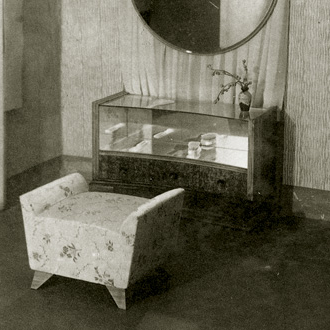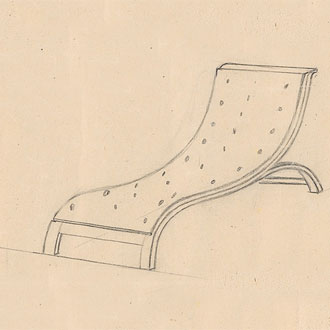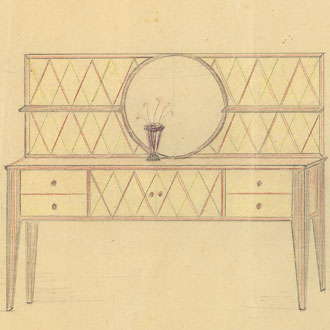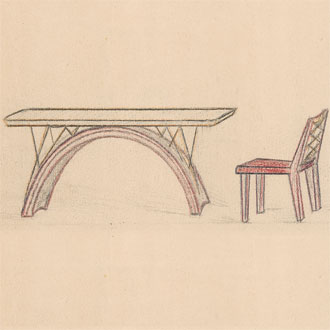
After some experience in the fields of interior decoration, building and stage-designing, Antonio Berdondini combined these technical skills with the arts of representation he learned at the Tommaso Minardi School of Graphics. So in 1926 he opened his “workshop”, a little atelier composed of the the entrance, the understairs closet and the little yard of the house at Vicolo Bucci n.6 in Faenza.
The first few years were quite hard, not only as a result of the oncoming historical economic crisis, but also because Berdondini was a young man who wanted to emerge from the world of old-fashioned furniture manufacturing to join the new up-to-date culture. At that time Faenza was an extremely lively centre, with a great tradition in the furnishing sector. Many people still remember that young workers from Cantù used to come to Faenza “to learn the art”!
In Saluzzo there were some skilful craftsmen from Faenza, who were considered real “artists” in cabinet-making (e.g. Comm. Bertoni).
So at first Berdondini found it hard to go beyond the predominant psychology of that sector and move away from the local manufacturing devoted mainly to classical antique-styled furniture production.
In fact, in his drawings and works of those years, we can perceive this detachment: his first works drew inspiration from what was later to be called “protodesign” by historians. This period originated from the last “déco” works and in the early Twenties it was usually called “Novecento”.
The “Novecento” style was actually a prevailing formal and cultural trend in Faenza, especially in the ceramic sector.
The learned milieu, made up of people such as Guerrini (founder of the Mosaic School in Ravenna and co-author of the Palazzo della Civiltà del Lavoro at EUR - Rome), G. Ballardini, Melandri, Matteucci, Gatti, Nonni, Drei, Ugonia, Rambelli, Gentilini and others, began to encourage the young Berdondini to attend their conferences, debates and discussions on ideality, art and the future. These artists were enthusiastic about these “new” ideas, and were helped in their work by the stimulating atmosphere created by some important (even today) cultural media, such as the International Ceramic Museum, the Ceramic School - founded by G. Ballardini in the years 1908-1913 -, the Town Picture Gallery and the “Tommaso Minardi” Drawing, Arts and Crafts School, founded at the end of the 18th century.
The International Ceramic Museum, founded on the occasion of the “Universal Expo”, soon became an important source of knowledge and control for the town of Faenza, and the local handicraft activity.
The first works exposed were private donations, with later ones coming from patrons from all over the world: this kind of medium held a new significance for the local craftsmen and the young Berdondini was ready to catch on to it.
As the Ceramic School had been founded in 1913, the Museum was given state grants, linked to the financial support allocated to the school.
At that time several skillful craftsmen of great value began to teach in the School, as teaching appeared the most suitable outlet for their activity, now that industry had produced a serious crisis for the role of workshop master.
Around the Thirties Antonio Berdondini established his activity and we can consider his regular participation in the exhibitions in his region as evidenceof his will to improve and his desire for challenge.

The works he put on show met with success on several occasions “abroad”, at Bologna and Florence, and in the period 1934-39, at the “Faentine Week” and “Cesenate Week” exhibitions. These were very peculiar exhibitions, which showed a kind of production that was very close to the cultural and formal trends in national and international furniture manufacturing.
Awards were not unusual for Antonio Berdondini’s craft-firm production: he won prizes and gold medals at the Bologna and Florence Fairs in 1938, 1939 and 1940, for his “New Style” and the high level of manufacturing.
The local newspapers of that time, speaking about those exhibitions of prestigious ceramics and furniture, gave special mention to the “bedrooms” (Corriere Padano, 1935), the “root wood dining room” (Corriere Padano and Resto del Carlino, 1937) and the “peculiar inlaid works” (Corriere Padano and Resto del carlino, 1938) of the Faentine cabinet-maker Berdondini. Some of these inlaid works on furniture were inspired by De Chirico’s pictures and by the works of the young F. Gentilini.
As a further commendation, after the “Littoriale” Fair he was allowed to put his award-winning furniture on show, for a period of two years, in the shop-windows of Via Santo Stefano in Bologna (in the CCCIA Mercanzia Palace).
Berdondini developed his qualities not only by attending the regional exhibitions, but also by taking part in higher level events, i.e. the “Triennale” at Milan and the Monza exhibitions.
In his production of those years, references are often visible to some outstaning designers, such as Luciano Baldassarri, Gio’ Ponti, Guglielmo Ulrich, Paolo Buffa and Melchiorre Bega, and to many technical devices and material choices Antonio Berdondini had become acquainted with during his frequent visits to the major craft workshops of the Milan and Brianza areas.

His determination to succeed allowed the Berdondini workshop to overcome all the serious difficulties. After the move to the larger premises of the ex-Virgines Convent in 1936 , by 1940 the business already had several workers and, in addition, they had up-to-date machinery and a permanent furniture showroom (see “Il piccolo negozietto dalle rosse piastrelle di Sieci” in “Giochi Perduti”, in “Canti alla Vita”, Gesualdi publisher, Rome 1978), in Via Mazzini, in the very centre of the town. Above all, the firm had a great number of excellent customers from all over the region, and from Tuscany and Rome too.
The success of these years was almost totally erased by the outbreak of the war: most of the various stores, containing the raw material, as well as the entire production of that time, which had been “evacuated” to the country surrounding the river Senio, were completely destroyed.
At the end of the war the workshop was engaged mainly in the restoration of war-damaged furniture. From 1947 on Antonio’s creative and productive activity acquired a new impulse, with limited series of furniture, which often re-proposed models of the early Forties. Moreover, he stepped up his work as designer and producer of a few exclusive high-level cabinet-making models, encouraged by his inceasingly frequent visits to the Milan interior design exhibitions, such as the “Triennale”, and others in Cantù, Lissone and Monza.

His son Gian Paolo became involved in the “workshop” at a very early age, and worked with his mother Angela on its activity and development. In 1959 he graduated at the Catholic University of Milan, Faculty of Economics and Business Studies, with a degree thesis on “The possible development of the wood furniture industry in Italy”. In the early Sixties he had the present large premises of the firm built, in Via Emilia Ponente, Faenza (see photo).
Antonio Berdondini designed the exteriors of the building with the same enthusiasm he showed in the design of his furniture. Moreover, the façade was decorated with ceramic panels representing the “history of furniture”, made by the artist Goffredo Gaeta.
Gian Paolo also changed the juridical status of the firm, once in 1962, and then again on June 2nd, 1966, keeping the name Berdondini and the strictly family organization of the business.
The new premises and organization were partly due to the outcome of his degree thesis, which was considered with great attention by the main sector organizations existing at that time.
The programme, which started in the period 1960-62, became a widely talked about example in Italy, especially in the North Milan area, which was later to develope new ways of furniture distribution, almost unknown at that time to the individual producers.
In the Sixties Gian Paolo took part in the establishment of the C.I.M. - Italian Furniture Centre - which was to become a sort of “Furnitureland” on the motorway leading from Milan to Switzerland. This programme was not successful, for the usual old reasons deeply rooted in the narrow outlook of the individual sector operators, unaccostumed to this futuristic open-mindedness.
In 1965 the Berdondini firm once again made a comeback in the chief international exhibitions, showing the “Velangela” living-room at the Milan Furniture Show. It was the fruit of Antonio Berdondini’s design and the graphical aid of Velia Donati, wife and active partner of his son Gian Paolo.
It was produced in a limited series, in India rosewood or national walnut. Its careful interior and exterior fittings, with highly refined cabinet details, caused a sensation among the most outstanding firms of that time. This product was appreciated not only by the public, but even by specialized critics; by the way, it was one of the only three productions to be mentioned by the renowned London magazine “World furniture”, in a context with over 3,000 exhibiting firms.
In those years, this particular attention to highly qualified design and furniture manufacturing led the Berdondini firm to set up and take part in the T.R.E.A. sector association . It was created to promote contemporary furniture, and guarantee high-level design.
The association was made up of 33 partners, from all over Italy. The best interior design producers of the time, that is to say Gianni Gabba, Canetoli, Berger, Bornello, Marcelletti and others, belonged to it.

Besides taking part in activities aimed at exploiting contemporary furniture, the Berdondini firm also participated in other promotional activities. In particular, in 1969 it displayed the wine-shop “the Passatore’s Barrels” in the yard facing its Faenza premises. It was the first advertising campaign of the Ente Tutela Vini Romagnoli.
It consisted of big barrels, vats and containers for DOC wines of Romagna: a kind of renewed marriage between two chief elements of the earth, wood and the grapevine, furniture and wine.
In the Seventies the firm worked on an expansion project for the development of the production sector with the building of new sheds where the mass-production of the “Velangela” was to be started. This furniture was then to have been put on sale for selected clients, provided by the best salesmen in the sector. Unfortunately this programme met with some burocratic obstacles, and so the firm was obliged to limit the production of that collection to only a few pieces.
Nevertheless the Berdondini firm continued its activity, which was characterized by high-quality, good-design furniture, frequently concentrating on custom-made interior design. The name of this firm has appeared in the “Ottagono” magazine since its first issues: the Architect Sergio Asti included it as one of the most qualified Italian industries.
Today its image still upholds the hard-earned prestige and care of its long and qualified progress. Its products are sold all over the world, and its registered mark is also widespread on the Internet.